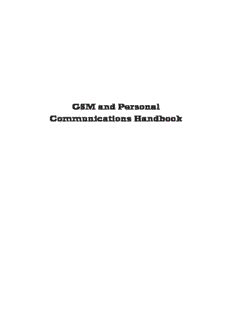
GSM and Personal Communications Handbook PDF
Preview GSM and Personal Communications Handbook
GSM and Personal Communications Handbook ForacompletelistingoftheArtechHouseMobileCommunications Library,turntothebackofthisbook. GSM and Personal Communications Handbook Siegmund M. Redl Matthias K.Weber Malcolm W. Oliphant Artech House Boston • London LibraryofCongressCataloging-in-PublicationData Redl,SiegmundM. GSMandpersonalcommunicationshandbook/SiegmundRedl, MatthiasWeber,MalcolmOliphant p. cm.—(ArtechHousemobilecommunicationslibrary) Includesbibliographicalreferencesandindex. ISBN0-89006-957-3(alk.paper) 1.Globalsystemformobilecommunications. 2.Personal communicationservicesystems. I.Weber,MatthiasK. II.Oliphant,MalcolmW. III.Title. IV.Series TK5103.483.R44 1998 621.3845'6—dc21 98-4710 CIP BritishLibraryCataloguinginPublicationData Redl,SiegmundM. GSMandpersonalcommunicationshandbook—(ArtechHousemobile communicationslibrary) 1.Globalsystemformobilecommunications I.Title II.Weber,MatthiasK. III.Oliphant,MalcolmW. 621.3’8456 ISBN 0-89006-957-3 CoverandtextdesignbyDarrellJudd. ©1998ARTECHHOUSE,INC. 685CantonStreet Norwood,MA02062 Allrightsreserved.PrintedandboundintheUnitedStatesofAmerica.Nopartof thisbookmaybereproducedorutilizedinanyformorbyanymeans,electronicor mechanical,includingphotocopying,recording,orbyanyinformationstorageand retrievalsystem,withoutpermissioninwritingfromthepublisher. Alltermsmentionedinthisbookthatareknowntobetrademarksorservice markshavebeenappropriatelycapitalized.ArtechHousecannotattesttotheaccu- racyofthisinformation.Useofaterminthisbookshouldnotberegardedas affectingthevalidityofanytrademarkorservicemark. InternationalStandardBookNumber:0-89006-957-3 LibraryofCongressCatalogCardNumber:98-4710 10987654321 Contents Contents Preface xv Acknowledgments xxi Part I GSM in the light of today 1 1 The changing scene—again 3 1.1 Thedigitalcellularevolution 4 1.2 Basicmarketfiguresandthesystemstandards 6 1.2.1 Cellularandpersonalcommunicationsservices: market presenceandpotential 10 1.2.2 Meetingthedemands 13 1.3 Aspectsonmarketingtheproduct 17 1.3.1 Serviceproviders 18 1.3.2 Fulfillmenthouses 20 1.4 Phones:shrinkthem,droptheirprice,and growtheirfeatures 20 1.4.1 What’syoursize? 21 v vi GSMandPersonalCommunicationsHandbook 1.4.2 Howlongcanyoustandby? 21 1.4.3 Ninety-ninecents? 22 1.4.4 WhatcanyoudothatIcan’t? 23 1.4.5 Multiplebandsandmultiplemodes 23 1.5 Whatispersonalcommunications? 26 1.5.1 PCS:definingtherequirements 27 1.5.2 PCS:thetechnicalsolutionstotherequirements 30 1.5.3 PCSandwhatsystemtechnology? 36 1.5.4 Wheredoesitlead? 37 1.5.5 GSMandPCSintheUnitedStates:anoverview 42 References x 2 From Pan-European mobile telephone to global system for mobile communications 51 2.1 GSM:whatitwasmeanttobeandwhat itbecame 52 2.1.1 TheinitialgoalsofGSM 52 2.1.2 Theinitialresults 52 2.1.3 Firstexperiences 54 2.1.4 PCNnetworksandDCS1800 55 2.1.5 PCS1900 59 2.1.6 UIC 63 2.2 TheroleoftheGSMMoU 65 2.3 ETSIandtheSpecialMobileGroup 67 2.4 Standards:thepresentandthefuture 69 2.4.1 GSMPhase1 72 2.4.2 GSMPhase2 72 2.4.3 GSMPhase2+ 74 2.5 GSMtypeapprovalissues 75 2.5.1 Theobjectives 77 2.5.2 Theauthorities 78 Contents vii References x 3 A look over the fence 81 3.1 Competitionorcomplement? 83 3.1.1 Cellularandpersonalcommunications 83 3.1.2 Cordlessaccess 84 3.1.3 Wirelessinthelocalloop 85 3.2 Whatelseisoutthere? 86 3.2.1 DigitalEnhancedCordlessTelecommunications 88 3.2.2 PersonalHandyPhoneSystem 96 3.2.3 PersonalAccessCommunicationsSystem 96 3.2.4 CDMA(IS-95) 101 3.2.5 TDMA(IS-136) 104 3.2.6 IS-661 111 3.3 Noncellulardigitaltrunkingsystems 117 3.4 Interferenceandhealthissues 122 References 125 Part II GSM services and features 127 4 The development of GSM standards and features 129 4.1 Phase1 132 4.1.1 Phase1teleservices 132 4.1.2 Phase1bearerservices 132 4.1.3 Phase1supplementaryservices 133 4.2 Phase2 134 4.2.1 Phase2teleservices 134 4.2.2 Phase2supplementaryservices 135 4.2.3 Phase2networkimprovements 136 viii GSMandPersonalCommunicationsHandbook 4.3 Phase2+ 138 4.3.1 Release96 138 4.3.2 Release97 143 4.4 Conclusion 144 References 146 5 GSM telecommunication services 147 5.1 BearerservicesinGSM 149 5.2 TeleservicesinGSM 152 5.3 ConnectiontypesinaGSMPLMN 152 5.3.1 Lowerlayercapabilities 153 5.3.2 Connections 153 5.3.3 Attributesbetweentwonetworks 155 5.4 Rateadaptation 157 5.4.1 Errorprotection 163 5.4.2 Terminalequipmentandmobiletermination 164 5.5 Radiolinkprotocol 165 5.5.1 Framestructure 166 5.5.2 ControlofRLP 167 5.5.3 Errorrecovery 171 5.5.4 RLPsummary 171 5.6 Accesstodifferentnetworks 172 5.6.1 TransmissionintothePSTN 172 5.6.2 Facsimiletransmission 174 5.6.3 TransmissionintotheISDN 175 5.6.4 TransmissionintothePSPDN 175 5.6.5 TransmissionintotheCSPDN 177 5.7 Faxservices 178 5.7.1 End-to-endviewviatheGSMinfrastructure 179 Contents ix 5.7.2 Configurationatthemobilestation 181 5.7.3 Transparentfaxservice 182 5.7.4 Nontransparentfaxservice 185 5.7.5 In-callmodification 186 5.8 Connectingamobilestationtoexternaldevices 187 5.8.1 Applicationforshortmessageservices 188 5.8.2 Remotecontrolofmobileequipment 190 5.9 Futuredevelopments 193 5.9.1 High-speedcircuit-switcheddata 194 5.9.2 Generalpacketradioservice 199 5.9.3 Packetdataonsignalingchannels 202 5.9.4 The14.4-Kbpsuserdatarate 204 5.9.5 Facsimileenhancements 204 5.9.6 Generalbearerservices 205 5.9.7 Emergencycallwithadditionaldatatransfer 206 References 206 6 Short message service 211 6.1 Shortmessageservice:pointtopoint 212 6.1.1 Implementationofpoint-to-pointSMSinthenetwork 213 6.1.2 AlphabetofSMS 228 6.1.3 ExampleofaSMS-MTmessageframe 228 6.1.4 Problemsthatcanoccurwhilesendingshortmessages 231 6.1.5 SMSandsupplementaryservices 232 6.1.6 UseofadditionaldevicesforSMS 233 6.1.7 Thefuture 235 6.2 SMScellbroadcast 237 6.2.1 ImplementationofCBinthenetwork 238 6.2.2 Contentsofacellbroadcastmessage 240 6.2.3 Futuredevelopmentsforcellbroadcast 243 References 244 x GSMandPersonalCommunicationsHandbook 7 Supplementary services 245 7.1 Introductiontosupplementaryservices 246 7.1.1 Networkentities 248 7.1.2 Passwordhandling 251 7.2 Callforwardingsupplementaryservice 252 7.2.1 Generalbehaviorofcallforwardingservices 253 7.2.2 Operationofcallforwarding 255 7.2.3 Conflictsforcallforwarding 259 7.2.4 Whopaysforwhat? 260 7.3 Callbarringsupplementaryservices 262 7.3.1 Callbarringforincomingandoutgoingcalls 263 7.3.2 Applicabilityofcallbarring 264 7.3.3 Restrictionstocallbarring 265 7.4 Lineidentificationsupplementaryservices 266 7.4.1 Callinglineidentification 266 7.4.2 Connectedlineidentification 268 7.5 Callwaiting 268 7.6 Callholding 271 7.7 Multipartycommunicationsupplementaryservice 272 7.8 Adviceofchargesupplementaryservice 275 7.8.1 Chargeadviceinformation 276 7.8.2 Adviceofcharge(information) 277 7.8.3 Adviceofcharge(charging) 278 7.9 Closedusergroupsupplementaryservices 279 7.10 Unstructuredsupplementaryservicesdata 281 7.11 ImplementationofSSinaGSMmobilestation 283 7.11.1 Implementationofnon-call-relatedSS 284 7.11.2 Implementationofcall-relatedSS 288
Description: